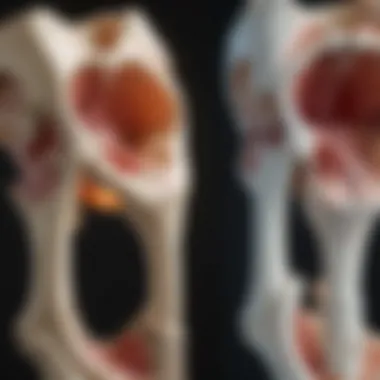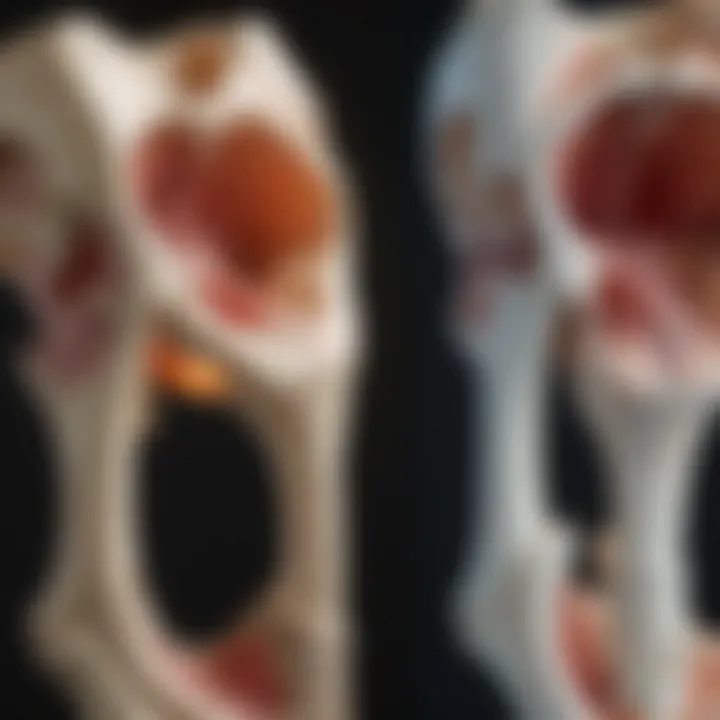Comprehensive Treatment Options for Osteopenia


Intro
Osteopenia is a condition marked by reduced bone density, which poses a significant risk for developing osteoporosis. Understanding the treatment options available for osteopenia is crucial for those affected. Proper management strategies can prevent further bone loss and promote overall bone health. This article delves into various treatment options ranging from lifestyle changes to pharmacological interventions.
Research Overview
Summary of Key Findings
Recent studies have shed light on the various treatment modalities available for osteopenia. Research indicates that a combination of lifestyle modifications and medications can substantially enhance bone density. Key findings suggest that regular physical activity, adequate nutrition, and in some cases, targeted medications yield the best results in managing this condition.
Importance of the Research
The significance of research in this field cannot be understated. Given the increasing prevalence of osteopenia and osteoporosis globally, identifying effective treatment methods is vital. This research not only aids healthcare professionals in designing individualized treatment plans but also empowers patients by providing them with knowledge to better manage their health.
Treatment Options
The treatment landscape for osteopenia includes a variety of approaches that are tailored to individual needs. Below are the main strategies:
- Lifestyle Modifications:
- Nutritional Strategies:
- Pharmacological Therapies:
- Engaging in regular weight-bearing exercises like walking, jogging, and strength training.
- Implementing weight management strategies to maintain a healthy body mass index.
- Quitting smoking, which is known to negatively affect bone health.
- Increasing calcium and vitamin D intake through diet or supplements. Dairy products, leafy greens, and fortified foods are excellent sources.
- Ensuring a balanced diet rich in nutrients necessary for bone health, such as magnesium and phosphorus.
- Medications like bisphosphonates (e.g., Alendronate) are often prescribed to help slow down bone loss.
- Hormonal therapies, including estrogen replacement for postmenopausal women, can also be beneficial in certain cases.
"Early intervention in osteopenia can lead to improved bone health and a lower risk of fractures in the future."
The End
In summary, managing osteopenia involves a multifaceted approach. Effective treatment requires a careful consideration of lifestyle, dietary habits, and medications. Continuous research is essential for advancing our understanding of this condition and developing better treatment protocols. Maintaining bone health is a shared responsibility between medical professionals and individuals alike.
Understanding Osteopenia
Osteopenia is a state of lower than normal bone density. It acts as a significant indicator for the risk of developing osteoporosis, a more severe condition characterized by a higher likelihood of fractures. Addressing osteopenia is crucial, not just for clinical reasons but also to improve the quality of life for individuals affected by this condition.
Understanding osteopenia involves recognizing the conditions' complexities and implications. It allows for early intervention, which is vital in preventing further deterioration of bone health. The discussion about osteopenia encompasses diverse factors, including how it affects different demographics, its underlying causes, and how it can be effectively managed through various treatment options.
Identifying osteopenia early can guide both health professionals and patients toward effective strategies to address potential complications.
Definition and Diagnosis
Osteopenia is defined as a decrease in bone mineral density, with T-scores ranging from -1 to -2.5, according to the World Health Organization's criteria. The diagnosis of osteopenia typically involves a dual-energy X-ray absorptiometry (DEXA) scan. This non-invasive test quantifies bone density and offers insight into bone health issues, enabling healthcare providers to determine appropriate treatment options.
Diagnosing osteopenia is often part of a broader assessment of bone health. For instance, individuals with risk factors such as advanced age, sedentary lifestyle, or certain medical conditions may undergo routine screenings. It is essential that patients discuss potential symptoms, family history, and lifestyle factors with their healthcare providers to facilitate an accurate diagnosis.
Prevalence and Risk Factors
Osteopenia is a common condition, particularly among older adults. Research indicates that approximately 34 million adults in the United States have osteopenia, highlighting its widespread presence. However, prevalence rates can vary across different populations due to genetic, environmental, and lifestyle factors.
Various risk factors contribute to the development of osteopenia. These include but are not limited to:
- Age: Bone density generally decreases with age.
- Gender: Women, especially post-menopause, are at a higher risk due to lower estrogen levels.
- Family History: A genetic predisposition can influence one’s likelihood of developing osteopenia.
- Body Weight: Low body weight may correlate with lower peak bone mass.
- Lifestyle Choices: Sedentary lifestyle, excessive alcohol consumption, and smoking can negatively affect bone health.
Awareness of these risk factors can enable individuals to take proactive measures to preserve their bone health.
Importance of Treatment
Understanding the importance of treating osteopenia is vital for several reasons. Acknowledging this condition allows for timely and effective interventions that can improve overall bone health and quality of life. Patients who are diagnosed with osteopenia are at a heightened risk of developing osteoporosis, a more severe bone condition. Therefore, proactive management is essential to prevent possible fractures and associated complications.
Consequences of Untreated Osteopenia
The consequences of not treating osteopenia can be significant and multifaceted. One major risk is the increased likelihood of fractures. As bone density decreases, the bones become more fragile. This fragility makes individuals susceptible to breaks even from minor falls or injuries. In severe cases, these fractures can lead to long-term disability, impacting a person’s ability to perform daily activities and diminishing their independence.
Additionally, untreated osteopenia can lead to chronic pain. Fractures may heal poorly or lead to complications, resulting in ongoing discomfort. The emotional toll cannot be overlooked either. The fear of falling and sustaining an injury may restrict social activities, fueling feelings of isolation or depression.


Moreover, the healthcare costs associated with treating fractures and managing complications are considerable. Preventive measures and early treatment can save both patients and healthcare systems from the financial burden of emergency care and rehabilitation.
Goals of Osteopenia Treatment
The main goals of treating osteopenia focus on enhancing bone density and ensuring overall bone health. One primary aim is to prevent the progression to osteoporosis. This includes regular monitoring of bone density and adjusting treatment as necessary.
Another key objective is to reduce the risk of fractures through both lifestyle changes and pharmacological interventions.
- Promote physical activity: Encouraging weight-bearing exercises helps strengthen bones and improve balance, reducing the risk of falls.
- Nutritional improvements: Ensuring adequate intake of calcium, vitamin D, and other essential nutrients contributes to better bone health.
- Limit risk factors: Identifying and mitigating factors such as smoking or excessive alcohol consumption can also help.
In addition, therapeutic strategies aim to educate patients about their conditions, thus fostering a proactive approach to managing their health. Personalized plans consider individual needs, preferences, and responses to treatment. By setting clear objectives, healthcare providers and patients can work collaboratively to achieve better health outcomes in managing osteopenia.
It is crucial to understand that early intervention in osteopenia can significantly alter the trajectory of bone health and prevent severe complications later in life.
Lifestyle Modifications
Lifestyle modifications are a pivotal component of managing osteopenia. They help improve bone density, promote overall health, and reduce the risk of progression to osteoporosis. Many individuals diagnosed with osteopenia may underestimate the role that daily habits can play in their bone health. However, integrating specific lifestyle changes can have significant impacts.
Physical Activity Recommendations
Engaging in regular physical activity is essential for maintaining and enhancing bone density. Weight-bearing and resistance exercises are particularly beneficial. Activities such as walking, jogging, dancing, and weight lifting can exert beneficial forces on bones, stimulating new bone formation.
Recommendations typically include:
- At least 150 minutes of moderate aerobic activity per week. This can be broken down into 30-minute sessions on most days.
- Strength training exercises at least twice a week, focusing on major muscle groups.
- Flexibility and balance exercises to prevent falls, such as tai chi or yoga.
It is important for individuals to consult with their healthcare provider before starting any new exercise regimen to ensure safety and appropriateness based on their health status.
Weight-Maintenance Strategies
Achieving and maintaining a healthy weight is crucial for bone health. Both underweight and overweight conditions may negatively affect bone density. Being underweight can lead to lower bone mass, while excess weight may increase the risk of fractures due to falls.
Key strategies include:
- Eating a balanced diet rich in calcium and vitamin D - optimizing these nutrients supports bone health.
- Portion control and mindful eating - helps prevent overeating and encourages weight management.
- Regular monitoring of body weight - assists in making necessary adjustments in diet and activity levels.
Weight loss should be approached carefully; extreme diets can compromise bone density. A gradual and balanced weight loss plan is advisable if needed.
Avoiding Risky Behaviors
Certain lifestyle choices can worsen bone health or lead to falls, presenting significant risks for individuals with osteopenia. Avoiding risky behaviors is essential for preventing fractures and maintaining bone strength.
Adopting safer practices includes:
- Limiting alcohol consumption: Too much alcohol can interfere with bone health and increase the risk of falls.
- Quitting smoking: Smoking has detrimental effects on bone density and can hinder calcium absorption.
- Being mindful of medication side effects: Some medications can affect balance or bone density; discuss all medications with a health professional.
"The cumulative effect of lifestyle changes can significantly lower the risk of fractures and improve quality of life, making it essential for individuals with osteopenia to reflect on their day-to-day choices."
By incorporating these lifestyle modifications, individuals can create a proactive approach to managing osteopenia, enhancing their bone health and overall well-being.
Nutritional Strategies
Nutritional strategies play a pivotal role in managing osteopenia. Proper nutrition is essential for maintaining and improving bone health. Adequate intake of specific nutrients can help counter the effects of reduced bone density. The following sections detail the importance of calcium, vitamin D, and other key nutrients that support bone structure and findings.
Calcium Intake Requirements
Calcium is a critical building block for bone tissue. The body requires calcium to maintain bone density and overall skeletal integrity. For individuals with osteopenia, it's crucial to ensure they consume sufficient calcium. Generally, adults aged 19 to 50 need about 1,000 mg of calcium daily, while those over 50 should aim for 1,200 mg.
There are many dietary sources of calcium. These include:
- Dairy products: milk, yogurt, and cheese are excellent sources.
- Leafy green vegetables: kale, broccoli, and collard greens provide calcium along with other nutrients.
- Fortified foods: some juices, cereals, and plant milks are fortified with calcium.
- Fish: salmon and sardines that are canned with bones contribute additional calcium.
It's also important to consider calcium absorption. Consuming calcium along with vitamin D facilitates better absorption. High doses of calcium supplements can sometimes lead to gastrointestinal issues, so it is often better to obtain calcium from food sources when possible.
Role of Vitamin


Vitamin D enhances calcium absorption in the gut and helps maintain adequate serum calcium and phosphate levels. This support is vital for bone remodeling. A deficiency in vitamin D can lead to weakened bone density, exacerbating osteopenia conditions.
For optimal bone health, individuals should aim for 600 to 800 IU of vitamin D daily, depending on age and health conditions. Natural sources of vitamin D include:
- Sunlight: simply getting adequate sunlight daily can help meet vitamin D requirements.
- Fatty fish: salmon, tuna, and mackerel are rich in vitamin D.
- Egg yolks: this is another nutritional source that contributes to vitamin D intake.
- Fortified foods: many brands of milk, orange juice, and cereals have added vitamin D.
Supplementation might be necessary for those who have limited sun exposure or dietary intake of vitamin D. Regular monitoring of vitamin D levels can help guide proper supplementation forms for individuals at risk.
Other Nutrients of Interest
Beyond calcium and vitamin D, other nutrients also play significant roles in bone health. Considerations include:
- Magnesium: This mineral contributes to bone structure and helps with calcium metabolism. Foods rich in magnesium include nuts, seeds, whole grains, and legumes.
- Vitamin K: Important for bone mineralization, vitamin K is found in leafy green vegetables and plays a role in blood clotting as well. It helps bind calcium in the bones and can aid in reducing fractures.
- Protein: Necessary for bone repair and maintenance, an adequate intake of protein from sources such as lean meats, legumes, and dairy is essential. Both plant and animal proteins should be considered for a balanced approach.
The role of nutrition in managing osteopenia can not be overstated; paying attention to dietary intake is critical to enhancing bone density and overall health.
Incorporating these nutrients into a daily diet can significantly impact bone health and help prevent further deterioration in those with osteopenia. Combining nutritional strategies with other interventions will provide a comprehensive approach to managing this condition.
Pharmacological Interventions
Pharmacological interventions play a crucial role in the management of osteopenia. These medical treatments are designed to help improve bone density, minimize the risk of fractures, and ultimately decrease the likelihood of progression to osteoporosis. The choice of medication can depend on individual risk factors, medical history, and specific patient needs.
In discussing these interventions, it is important to consider various options, the benefits they offer, and potential side effects. Effective management also involves monitoring and regular reassessment of treatment efficacy.
Bisphosphonates
Bisphosphonates are often recommended as first-line treatment for osteopenia. These drugs work by slowing down the bone resorption process. This allows the bone formation to take precedence, thus gradually helping to rebuild bone density over time. Commonly prescribed bisphosphonates include Alendronate and Risedronate.
The primary advantage of bisphosphonates is their ability to reduce the risk of fractures significantly. Studies have shown that patients using these medications experience fewer vertebral fractures in comparison to those who do not.
However, there are some considerations. Patients might experience side effects such as gastrointestinal discomfort or, in rare cases, osteonecrosis of the jaw. Because of these potential risks, the choice to use bisphosphonates requires careful assessment by healthcare professionals, ensuring that the benefits outweigh any risks.
Estrogen-related Therapies
Estrogen therapy is another pharmacological option, particularly for postmenopausal women. Estrogen has a well-established role in maintaining bone density. When estrogen levels fall, such as during menopause, the rate of bone resorption increases.
Using estrogen-related therapies can help mitigate this loss. Selective Estrogen Receptor Modulators (SERMs), like Raloxifene, are often utilized as they offer bone protection with a reduced risk of some side effects linked with traditional hormone replacement therapy.
Despite their benefits, estrogen therapies are not suitable for everyone. Increased risk of certain cancers, thromboembolic events, and cardiovascular diseases must be carefully considered before initiating treatment. Regular monitoring becomes vital to ensure patient safety and treatment effectiveness.
Other Medications
Beyond bisphosphonates and estrogen-related therapies, other medications may be prescribed based on individual circumstances. For instance, Denosumab is a monoclonal antibody that inhibits osteoclast formation, thereby decreasing bone resorption. It is a suitable option for those who cannot tolerate bisphosphonates.
Another option is Teriparatide, a parathyroid hormone analog that stimulates bone formation. It is generally used in severe cases or when other treatments fail. Each of these medications has its own efficacy and side effect profile, necessitating detailed discussions between healthcare providers and patients.
"A tailored approach to pharmacological interventions helps ensure that patients receive the most appropriate treatment for their unique situations."
In summary, pharmacological interventions represent an essential element in the management of osteopenia. Understanding each option's benefits, risks, and mechanisms enables informed decisions for patients and providers alike.
Alternative Therapies
Alternative therapies are gaining attention as adjunct treatments for osteopenia. These options may complement traditional approaches and provide some benefits. Understanding their role is essential for developing an effective treatment plan. Many individuals seek alternative therapies due to concerns about the side effects of conventional medications. Therefore, exploring options like herbal supplements and acupuncture can empower patients in their health journey.
Herbal Supplements and Their Efficacy
Herbal supplements are widely used to support bone health. Some of the more popular supplements include alfalfa, red clover, and nettle leaf. Each has its unique set of constituents that may contribute to bone density. Here are some details on a few commonly used herbal supplements:
- Calcium-rich herbs: Such as nettle leaf, may help maintain proper calcium levels in the body.
- Phytoestrogens: Present in red clover, can offer estrogen-like effects, potentially benefiting postmenopausal women.
- Other antioxidants: Like curcumin or ginger, might contribute to overall bone health by reducing inflammation.
It's important to consult a healthcare provider before starting any supplement, as some may interact with medications or have side effects.
While preliminary studies show potential benefits, the efficacy of these supplements requires more robust scientific evidence. Randomized control trials are needed to establish their effectiveness in increasing bone density specifically for those with osteopenia.
Acupuncture and Osteopenia


Acupuncture is another alternative therapy that some individuals consider for osteopenia. This traditional Chinese medicine technique involves inserting thin needles at specific points in the body. Although the direct connection between acupuncture and bone health is not clearly understood, it is proposed that acupuncture may aid in multiple ways:
- Pain relief: Acupuncture may help alleviate discomfort related to bone pain.
- Improved circulation: Enhanced blood flow might support nutrient delivery to the bones, which is essential for maintaining bone health.
- Stress reduction: The relaxation associated with acupuncture can be beneficial, as stress negatively impacts overall health.
Evidence remains mixed on acupuncture's effectiveness for osteopenia. Some studies highlight positive outcomes, while others show no significant impact. Ongoing research continues to explore its potential benefits. Like with herbal supplements, individuals should discuss this therapy with healthcare providers to ensure it fits their treatment plan.
Monitoring and Follow-Up
Monitoring and follow-up play a crucial role in the management of osteopenia. Careful tracking of bone density and treatment effectiveness helps in tailoring interventions to each individual’s unique needs. With osteopenia being a precursor to osteoporosis, observing changes in bone health can prevent further deterioration. This section will discuss the importance of regular bone density testing and how to assess treatment efficacy effectively.
Regular Bone Density Testing
Regular bone density testing is essential for anyone diagnosed with osteopenia. These tests, often performed using dual-energy X-ray absorptiometry (DEXA), quantify bone mineral density (BMD), allowing healthcare providers to monitor changes over time. The results help to identify trends—whether improvements or declines are occurring—in bone health.
Structure of appropriate testing protocol typically includes:
- Baseline Testing: Establishes a starting point for monitoring.
- Follow-Up Testing: Depending on individual risk factors, testing is recommended every one to two years.
- Assessment of Risk Factors: Evaluating personal and family history aids in understanding the need for more frequent testing.
The data garnered from these tests inform treatment decisions, such as continuing with a current medication or incorporating new lifestyle changes. By consistently monitoring bone health, potential complications associated with untreated osteopenia can be minimized.
Assessing Treatment Efficacy
Determining how well treatments are working requires ongoing assessment and careful interpretation of test results. Evaluating treatment efficacy involves looking beyond simple numbers of BMD to include the patient’s overall health status and lifestyle changes. Some key considerations may include:
- Regular Consultations: Frequent checks with healthcare providers ensure adaptations to the treatment plan, if necessary.
- Patient Feedback: Symptoms or perceived changes in physical health should be communicated to assess whether current interventions are helping.
- Combination Approaches: Employing a mix of lifestyle changes, nutritional strategies, and pharmacological treatments can enhance overall effectiveness.
This comprehensive approach not only involves measuring BMD but also evaluating how proactive changes affect patients’ wellbeing and risk for fracture.
Ultimately, tracking treatments effectively contributes to a systematic understanding of each patient's journey through osteopenia. Addressing both medical and lifestyle factors through regular follow-ups leads to better management strategies, paving the way for healthier bones and improved quality of life.
Future Directions in Osteopenia Research
In the realm of bone health, osteopenia remains a significant concern due to its status as a precursor to osteoporosis. Understanding future directions in osteopenia research is crucial for developing effective treatment strategies. Ongoing studies are focusing on personalized medicine, novel therapeutic approaches, and genetic influences that may pave new paths for management. These areas not only hold promise for improving existing interventions but also for discovering innovative solutions to combat this condition more effectively.
Emerging Therapies
Emerging therapies represent an exciting frontier in the management of osteopenia. Current research is exploring various new medications and biological agents that target bone density enhancement. Some of these therapies are focusing on mechanisms that go beyond traditional treatments, such as bisphosphonates and hormone replacement therapies. For example, research into the role of monoclonal antibodies and other biologics is receiving greater focus. These therapies may provide options for individuals who do not respond well to existing treatments.
Additionally, advancements in drug delivery systems are being explored. Such systems aim to enhance the absorption and efficacy of established medications. Utilizing nanotechnology could lead to more effective systemic and localized treatments, minimizing side effects while maximizing outcomes. This approach is particularly vital for those at high risk of osteoporotic fractures.
Ultimately, staying informed about these emerging therapies can empower both patients and professionals to make educated choices that can positively influence bone health.
Genetic Factors and Personalized Treatment
As research progresses, understanding genetic factors related to osteopenia is becoming increasingly important. Genetic predispositions can significantly impact how individuals respond to treatments. For instance, variations in bone metabolism genes can influence the effectiveness of dietary calcium and vitamin D supplementation. By identifying these genetic markers, healthcare providers can tailor treatments to suit individual patients more closely.
Personalized treatment plans based on genetic profiles offer the potential for more effective management of osteopenia. This strategy can lead to more precise dosing of medications and enhanced monitoring tailored to an individual's unique physiological responses.
Furthermore, studies are investigating how to leverage genetic information to anticipate the risk of developing osteoporosis. This predictive capability allows for early intervention strategies that could dramatically alter patient outcomes.
With the increasing knowledge of genetic factors influencing osteopenia, it becomes imperative for future research to explore how these insights can refine treatment protocols.
Culmination
The conclusion is a crucial part of any article as it synthesizes the main ideas discussed and reinforces their significance. In the context of our discussion on treatment options for osteopenia, the conclusion serves several important roles. It summarizes the various treatments available, emphasizing the multifaceted approach required to effectively manage this condition. This comprehensive view underscores that there is no single solution but rather a combination of lifestyle changes, nutritional strategies, and pharmacological interventions that can enhance bone health and mitigate risks associated with lower bone density.
Summary of Key Points
In this article, we have explored the following key points related to osteopenia treatment:
- Understanding Osteopenia: Defined osteopenia and the importance of early diagnosis.
- Importance of Treatment: Discussed the potential consequences of untreated osteopenia and outlined treatment goals.
- Lifestyle Modifications: Suggested changes including physical activity, weight management, and avoiding risky behaviors.
- Nutritional Strategies: Highlighted the need for adequate calcium and vitamin D intake, alongside other nutrients.
- Pharmacological Interventions: Described the roles of bisphosphonates, estrogen-related therapies, and other medications.
- Alternative Therapies: Evaluated herbal treatments and acupuncture and their relevance to osteopenia management.
- Monitoring and Follow-Up: Stressed the importance of regular bone density testing and assessing treatment efficacy.
- Future Directions in Research: Identified emerging therapies and the potential for personalized treatment based on genetic factors.
Each of these elements combines to form a holistic view of osteopenia management and highlights the importance of a proactive approach.
Encouragement for Early Intervention
Encouraging early intervention is essential for individuals at risk of osteopenia. By seeking guidance and adopting treatment strategies earlier, patients can significantly improve their long-term bone health. Early intervention allows for timely lifestyle adjustments, enabling better outcomes and preventing progression to osteoporosis.
It is important for individuals to consult healthcare providers if they suspect they may be at risk for osteopenia. Tools such as bone density tests can help assess bone health and guide the necessary steps for improvement. Furthermore, staying informed about the latest research and advancements in treatment options can empower individuals to make educated decisions regarding their health.
In summary, a proactive stance towards managing osteopenia not only elevates health outcomes but also fosters an improved quality of life. Taking action early is a testament to valuing one’s health and well-being.



